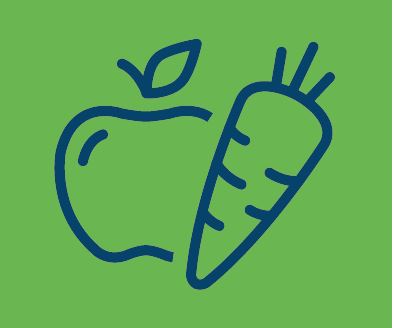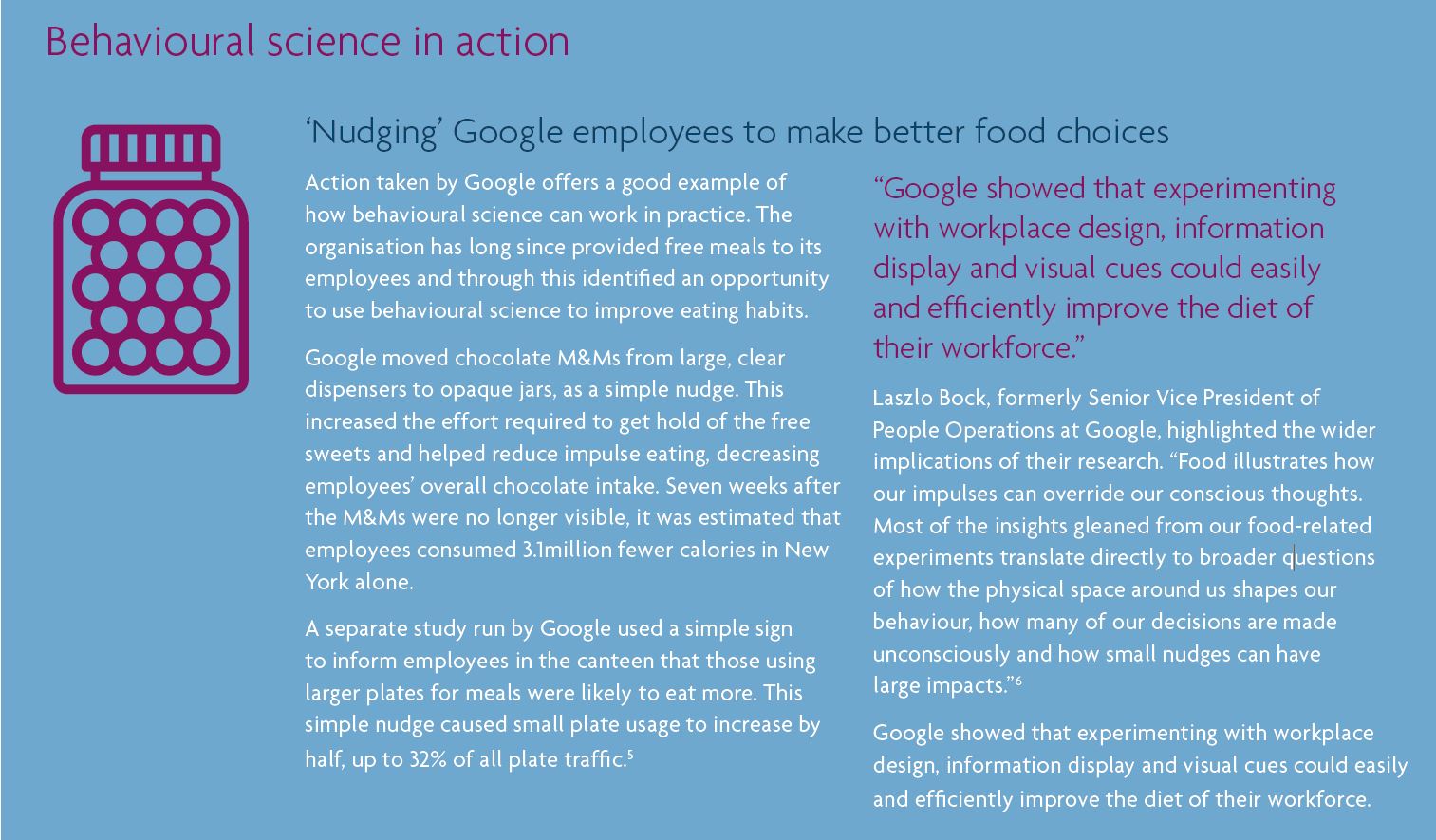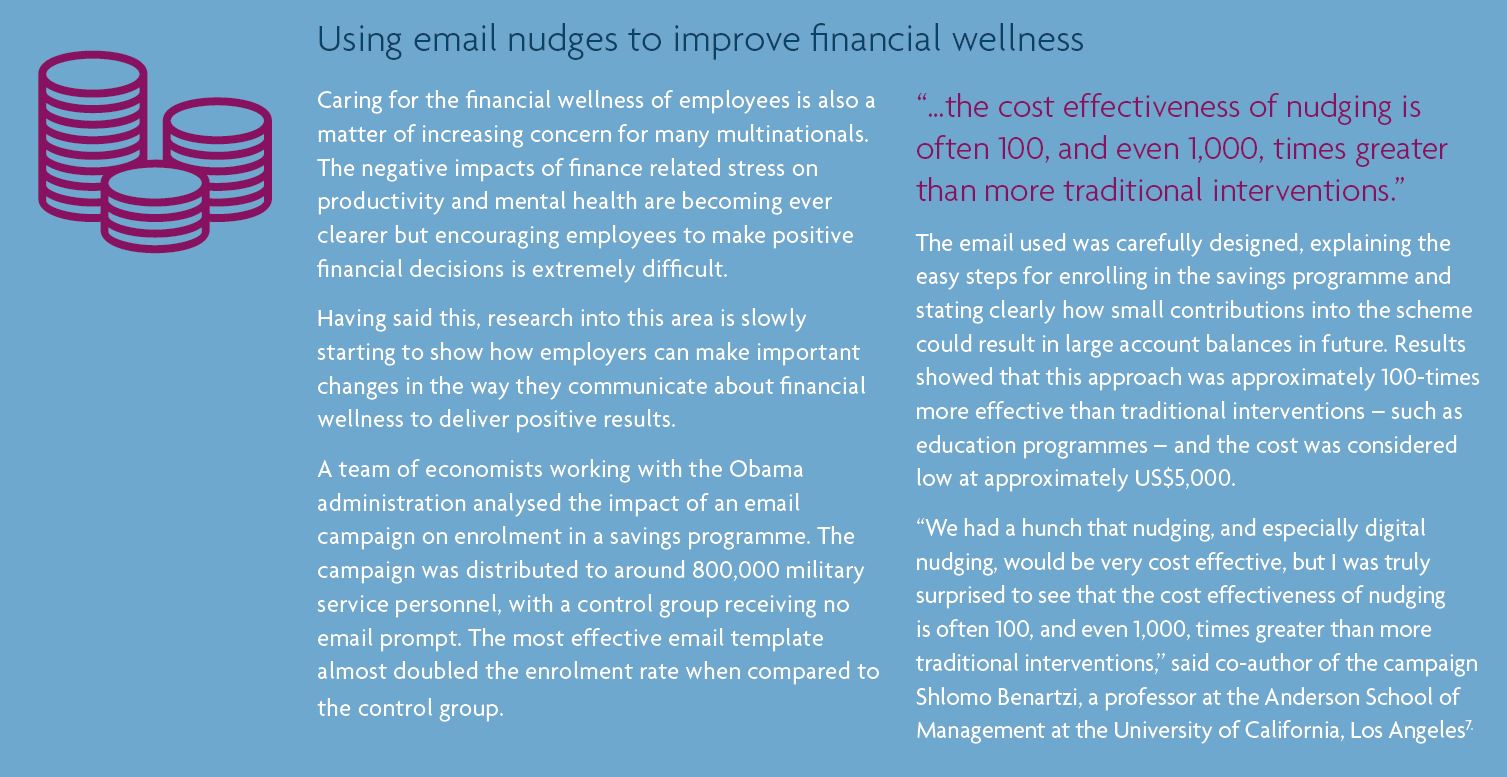NEWS
Tuesday 2 April 2019
Changing our habits and behaviour can be really difficult, especially when it comes to decisions we might make about our health and wellness. They tend to mean cutting out things we know are not as good for us but that we really enjoy. Have you ever set yourself the goal to watch less
TV or exercise more and then failed to follow through? What about choosing the healthy option in a restaurant when faced by all those delicious but fattening dishes?
Well, then it follows that this challenge is even more difficult when you’re trying to change the behaviours of others.
Multinationals looking to tackle rising healthcare costs, increase productivity and decrease absenteeism with behaviour-change programmes, face the incredibly difficult task of firstly convincing their employees to make healthier choices and then convincing them to keep doing it.
According to a global study of 500 executives by IMD.org, managers believe that only 50% of attempts to change employee behaviours are successful.1 Many less healthy behaviours are almost unconscious – putting that sugar in your coffee, picking up one of the sweet treats a colleague has brought in as you walk past – and many habits are formed and practiced outside of work.
But with employees spending 60% of their waking hours in the workplace, 2 it should provide employers with the perfect opportunity to infl uence health-related behaviours in a positive way. How can employers encourage their staff to make choices and engage in new habits that will help them lead healthier lives and keep medical costs down? A win-win for all involved.
lives and keep medical costs down? A win-win for all involved.
“...only 50% of attempts to change employee behaviours are successful”
The case for behavioural science
Evidence has shown that if employers can gain a greater understanding of human behaviour they can introduce programmes, described as ‘nudges’, to change habits and encourage employees to live more active and healthy lifestyles. Using behavioural science techniques can make positive behaviour change easier to achieve, often by working on instinct, unconscious decision making and ease of access to healthy options.
Many employers already use behavioural techniques to draw on unconscious bias and help them improve their sales and influence the behaviours of their customers. Yet, only now are they starting to look to these same techniques to help influence the decisionmaking of their own employees.
Using behavioural science techniques in the workplace
So, how do you implement a behavioural science-based approach to improving health and wellness in the workplace? The first step is to identify the most challenging areas. For example, is a widespread smoking habit driving up the cost of treating respiratory disease? Are working practices decreasing the likelihood of employees doing exercise?
By using in-depth health and wellness reporting, multinationals can identify the health problems that are most affecting their employees in a region, country or even a specific city. Whether the concerns are around eating habits, smoking, stress, sleep, or lack of exercise, analysing this data can be crucial in helping to create the most impactful campaigns – the ones most likely to encourage long-term behaviour change. And implementing those campaigns is the next step.
Three theories and their practical application for changing behaviour
As with many concepts, talking is all very well but seeing how the theory can be applied in practice is vital if you are to be successful. Here are three behaviour science theories and how they can be used to influence employees’ habits.
Loss aversion
Theory: people are usually more motivated to avoid losing something they already have, than getting something new.
In practice: rather than simply offering a medical check-up at work, tell employees they have to take up the option of a free check-up before a set date. After that date they will lose the free option and will have to pay for it. You can also offer a free activity tracker (such as a smart watch) to your employees but explain that they must return it if they don’t hit required exercise targets.
Decision anchoring
Theory: the first bits of information we learn about any topic, or the first things we see, tend to “anchor” and influence our final decision.
In practice: move the healthiest foods to the entrance of the staff canteen or kitchen. Research shows that ‘first seen’ foods are the ones most selected. Over 75% of diners selected the first food they saw and the first three foods a person encountered in a buffet
made up two-thirds of all the foods they took.3
Hyperbolic discounting
Theory: people are more likely to take a smaller reward now than wait for a larger reward.
Actually, it is more than this and seemingly quite illogical! People will still opt for the smaller reward even if the wait for the larger one is quite short. They tend to opt for the larger reward only if the delay in receiving it is much longer.
In practice: encourage employees to agree to increase their pension contributions on receiving a pay rise, before they actually receive it. This way they do not receive the smaller reward now. Instead they are happy to agree to a larger, long-term reward that they will not receive for many years. People who do agree to allocating a portion of their future salary increases towards retirement savings end up saving more.4
“By using in-depth health and wellness reporting, multinationals can identify the health problems that are most affecting their employees...”


Identifying barriers to success
One of the biggest challenges facing those implementing behavioural science strategies is measuring and determining the return on investment. How do we know the strategy had a real impact? Many of the behaviours employers seek to change are unconscious, so traditional Human Resources (HR) evaluation models such as staff surveys won’t work. One strategy is to use A/B testing – exposing different groups of employees to different programmes to compare and measure their effectiveness.
“It can also be hard to demonstrate an immediate return on investment when the impact of interventions may take time as employees are nudged away from poor habits.”
Also, as implementing many of these programmes is, by necessity, based on a “test and learn” approach, it can be difficult to secure full engagement and commitment from the C-suite and key decision makers. Senior management tend to be susceptible to a status quo bias, preferring the safety of doing
things in the same way as before. It can also be hard to demonstrate an immediate return on investment when the impact of interventions may take a long time to become evident. Nudging employees progressively away from poor or unhealthy habits is unlikely to be a quick process.
Equally, it is important for employers to bear in mind that less healthy habits and behaviours seen in the workplace may actually have been formed at home or from childhood. Changing behaviours practised at work need to transfer to an employee’s wider lifestyle.
Conclusion
Behavioural science can provide multinationals with a powerful set of tools and ideas to address the health and productivity of their employees – and ultimately their medical costs. The changes can range from the very simple, such as rearranging the snacks in a vending machine so the healthiest items are n the most prominent positions to the far more complex and long-term. Evidence suggests that small nudges can yield big results so it’s a good place to start.
Also, using smart tools like text messaging, emails and chat bots – a computer programme designed to simulate conversation, especially over the internet – that are readily available, can provide opportunities to deliver highly personalised programmes and affect targeted long-term change.
And, the use of data analytics and sophisticated tools that help work out the potential return on investment from implementing behaviour change campaigns, thereby proving the cost-savings of these interventions, can make them an easier sell to HR and C-suite decision makers.
At MAXIS GBN, we offer health and wellness programmes designed to help multinationals identify medical cost drivers and tools to help address them. Soon we are launching the MAXIS WIT (Wellness Intelligence Tool), an innovative new tool that enables employers to work out the potential health cost savings they could make by implementing specific targeted health campaigns in their business. We will be sharing more information on this soon.
1 Authors – Professor Shlomo Ben-Hur and Karine Avagyan, with Lindsay McTeague https://www.imd.org/research-knowledge/articles/how-can-you-motivate-employees-to-change-their-behavior/ (sourced March 2019)
2 Author – Joanne Allen https://www.thehrdirector.com/features/the-workplace/obesity-workplace-time-action/ (sourced March 2019)
3 Authors – Brian Wansink and Andrew S. Hanks https://journals.plos.org/plosone/article?id=10.1371/journal.pone.0077055 (sourced March 2019)
4https://prismic-io.s3.amazonaws.com/fincap-two%2Fd5312602-e0b0-4d6e-890b-249d408b608c_financial-capability-lab-report-may18.pdf (sourced March 2019)
5 Author – Cliff Kuang https://www.fastcompany.com/1669355/6-ways-google-hacks-its-cafeterias-so-googlers-eat-healthier (sourced March 2019)
6Extract from Lazlo Bock’s book Work Rules! https://www.linkedin.com/pulse/how-i-lost-30-pounds-over-two-years-kept-off-laszlo-bock/ (sourced March 2019)
7 Author – Association for Psychological Science https://www.sciencedaily.com/releases/2017/06/170608072859.htm (sourced March 2019)
This document has been prepared by MAXIS GBN and is for informational purposes only – it does not constitute advice. MAXIS GBN has made every effort to ensure that the information contained in this document has been obtained from reliable sources, but cannot guarantee accuracy or completeness. The information contained in this document may be subject to change at any time without notice. Any reliance you place on this information is therefore strictly at your own risk. This document is strictly private and confidential, and should not be copied, distributed or reproduced in whole or in part, or passed to any third party.
The MAXIS Global Benefits Network (“Network”) is a network of locally licensed MAXIS member insurance companies (“Members”) founded by AXA France Vie, Paris, France (AXA) and Metropolitan Life Insurance Company, New York, NY (MLIC). MAXIS GBN, registered with ORIAS under number 16000513, and with its registered office at 313, Terrasses de l’Arche – 92 727 Nanterre Cedex, France, is an insurance and reinsurance intermediary that promotes the Network. MAXIS GBN is jointly owned by affiliates of AXA and MLIC and does not issue policies or provide insurance; such activities are carried out by the Members. MAXIS GBN operates in the UK through UK establishment with its registered address at 1st Floor, The Monument Building, 11 Monument Street, London EC3R 8AF, Establishment Number BR018216 and in other European countries on a services basis. MAXIS GBN operates in the U.S. through MetLife Insurance Brokerage, Inc., with its address at 200 Park Avenue, NY, NY, 10166, a NY licensed insurance broker. MLIC is the only Member licensed to transact insurance business in NY. The other Members are not licensed or authorised to do business in NY and the policies and contracts they issue have not been approved by the NY Superintendent of Financial Services, are not protected by the NY state guaranty fund, and are not subject to all of the laws of NY. MAR00382/0319